How Lucid Plans to Avoid Tesla's Quality Control Pitfalls
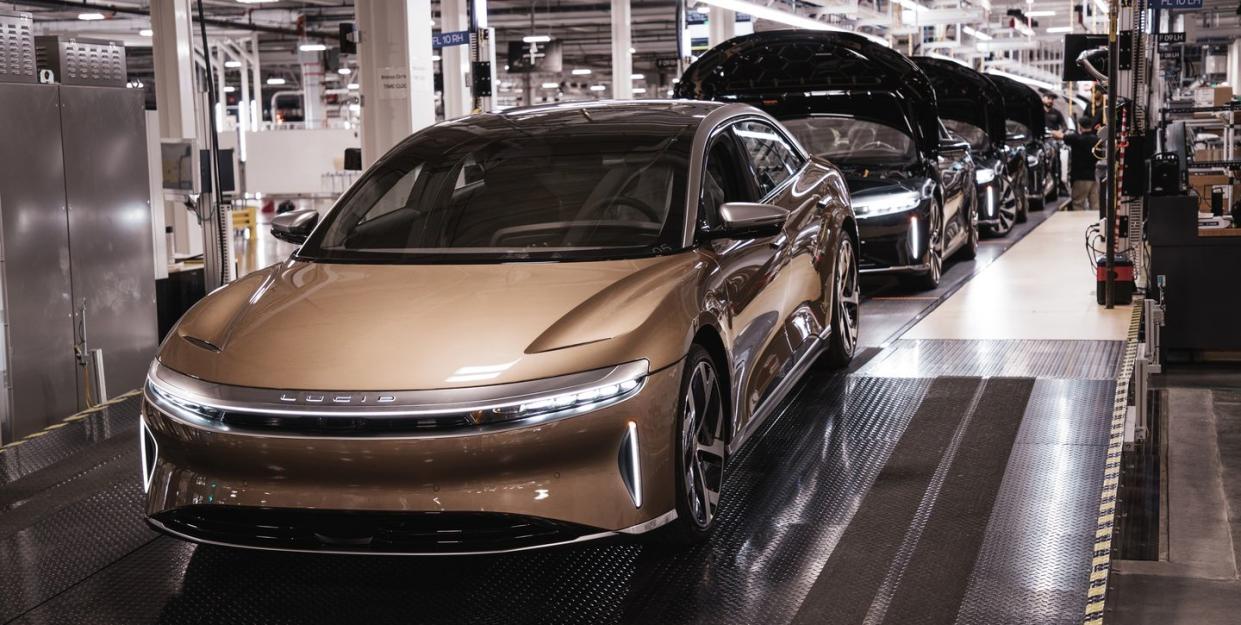
- Oops!Something went wrong.Please try again later.
Lucid Motors’ big, $700 million car plant rises in the Sonoran Desert in Arizona, and big dreams rise with it. In this EV start-up’s early days—where a few slips could spell the difference between bonanza and bankruptcy—one of those dreams is to avoid the quality nightmares that continue to plague Tesla. The kind that had Elon Musk sleeping under his desk in Fremont, California, famously moaning about his company being “in production hell.”
Peter Rawlinson, the former Tesla Model S chief engineer and current thorn in Musk’s side, has no intention of bunking down in Casa Grande. Lucid’s sparkling plant, one hour south of Phoenix, becomes the first brand-new EV assembly plant in North America. (Tesla, Rivian and long-shot Lordstown Motors have all chosen to convert defunct legacy-automaker factories for EV production). Prior to Road & Track’s exclusive all-day drive in the 520-mile-range Air Dream Edition—the unquestioned new benchmark in electric sedans—I toured the facility with Lucid’s manufacturing leaders, each counting decades of car-building expertise.
“We are now an automaker, ready to go,” says an enthused Steve Inglis, who clocked 30 years at Ford before joining Lucid as director of body structures manufacturing.
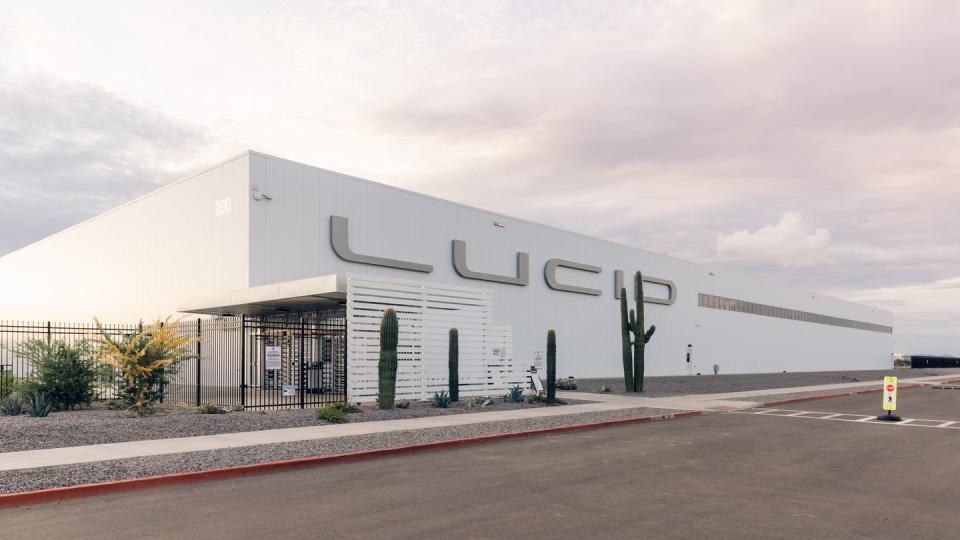
“This is production heaven; no production hell is going to happen here,” Inglis vows of the factory, which aims to churn out 20,000 Airs in 2022. About 1100 American employees are already on the job, with the possibility of 6000 if a four-phase expansion goes according to plan.
Musk’s groundbreaking models continue to dominate the EV industry; Tesla is on track for nearly 1 million global sales this year. But beyond the hosannas, Tesla has faced withering criticism for quality-control issues ranging from defective paint, faulty touchscreens and misinstalled seats to unsightly panel gaps that recall Detroit’s malaise era, before the Toyota Production System revolutionized global manufacturing and left Detroit automakers scrambling to adapt. Tesla finished dead last among 32 auto brands in J.D. Power’s 2020 Initial Quality Study. The EV maker’s brutal average of 250 reported problems per 100 vehicles was nearly twice that of first-place Dodge, and 50 percent worse than the industry average of 166 problems per 100 vehicles.
To avoid a similar fate, Lucid assembled an all-star manufacturing team, and gave it free rein to integrate the latest factory tech and quality controls. They include Mike Boike, Lucid’s director of manufacturing and head of Arizona operations, whose previous stops include Kia, DaimlerChrysler and GM. Boike says 2300 parts from 300 suppliers come together to make a single Air, a complicated dance that can be tripped up by one faulty part or process.
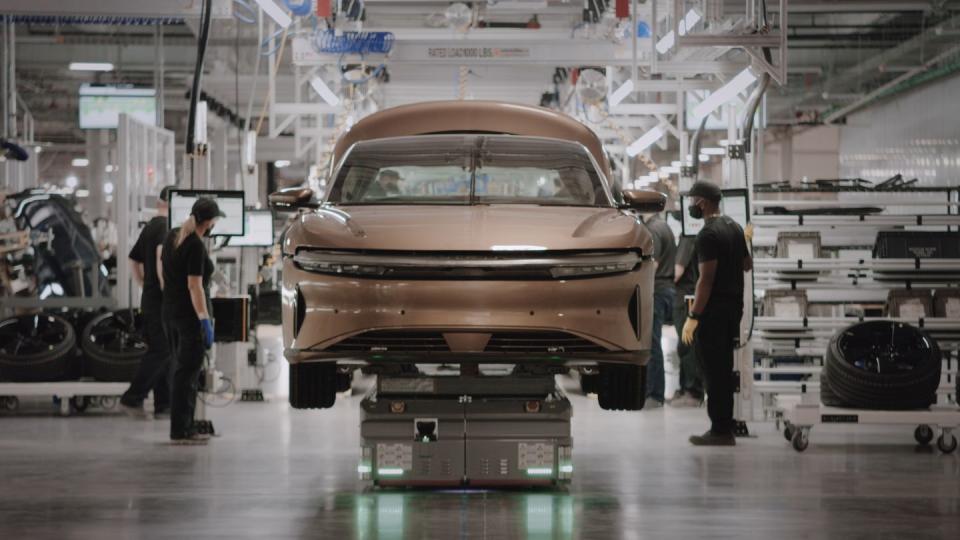
At Lucid’s nearby satellite powertrain facility—set to be folded into the expanding factory—we watch the Air’s power units come together, a testament to the company’s obsession with miniaturization and efficiency. These compact powder kegs boast nearly three times the power density of Tesla’s best, at 3.98 horsepower per pound of mass. Motor, gearbox, inverter and differential, not to mention 650 horsepower, are all packed into a single unit that weighs just 163 pounds and can fit inside a standard roller bag. Power units, one on each axle for all-wheel drive models, are fed by 6600 cylindrical battery cells in 22 modules. Another Lucid innovation uses aluminum ribbon instead of conventional wire to link cells; engineers say that saves 80 horsepower that would otherwise be wasted due to electrical resistance. We watch robots test individual battery cells and install them in a flat skateboard housing that’s also a structural member. Another sci-fi scale robot, the largest I’ve seen in an auto plant, recalls a blue-collar Iron Giant: It can lift more than 3700 pounds, and hoists completed battery packs into a rack.
Those battery cells are fixed with adhesive and cured for 26 minutes, and the whole shebang is closed with a metal cooling plate. Sandy Munro, the Detroit-area engineer who’s become internet famous for his teardowns of Teslas and other cars, says that cooling plate is the new standard in EVs, versus Tesla’s outmoded, space-wasting thermal circuit that snakes between cells. (Battery cells emit most heat from their terminal ends.) Tesla will adopt a similar cooling plate for models powered by its upcoming, large-format batteries.
At the main plant, a massive paint shop illustrates Lucid’s mindset. Cars move sideways through the various baths and dips, saving space compared to the conventional nose-to-tail arrangement for a more efficient factory footprint. A dry-scrub paint process, just gaining traction in the auto industry, eliminates the traditional water curtain that captures overspray, which requires pricey disposal of hazardous material and consumes millions of gallons of water. The more sustainable dry system recirculates spray-booth air through scrubber chambers that capture particles and convert them to limestone-like dry waste that can be recycled into cement. Another efficient process air-dries the primer coat in minutes, eliminating a stop in a primer oven before base and clear coat. I crouch to eyeball the paint on some of the first customer Airs off the line. It looks gorgeous; smooth enough to satisfy the most persnickety luxury buyer, and miles better than Tesla’s still-hapless paint operations, notorious for orange-peel blemishes and other visible defects.
“The start-up decisions you make today can’t be easily changed,” says Boike. “Whatever tech you choose is largely going to be there for the next 30 years.”
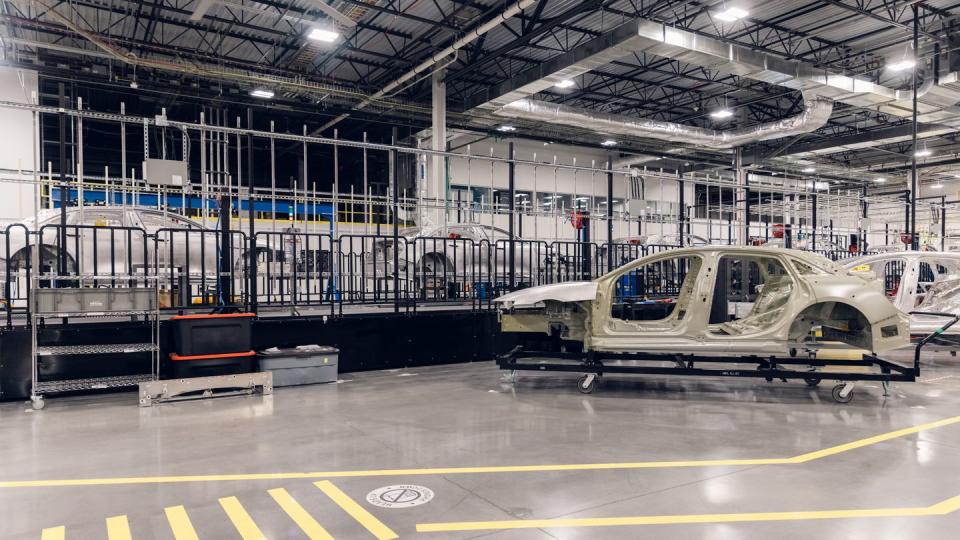
The Lucid’s sophisticated body-in-white is displayed on a wall. It’s entirely aluminum, aside from a small composite floor pan in the back-seat area. A mix of castings and extrusions are bonded by rivets, screws, adhesives and only a few welds. A robotic laser welder, hard at work behind an eye-protecting orange screen, joins an upper window frame in a space-saving process that allows larger side window glass.
Automated Guided Vehicles, or AGV’s, move Airs along the assembly line with no need for space-wasting overhead tracks or a reinforced ceiling. Unlike in conventional car factories, here the whirling robots perform multiple tasks for efficiency and cost savings at this initial low-volume stage. “They’ll get single jobs when we hit high velocity,” says Boike.
The first Airs off the line are all $170,500 Dream Editions bound for early adopters—limited to 520 copies, with up to 1111 horsepower and the aforementioned 520 miles of range. Obviously, six-figure luxury sedans aren’t a growth industry. So they’ll soon be joined by far more affordable versions, including next year’s single-motor Air Pure, with 480 horsepower and roughly 406 miles of range for $78,900. That’s about $12,000 less than a Model S Long Range, or $24,000 less than a Mercedes-Benz EQS with 151 fewer horsepower and a mere 350-mile range. And that’s for the least-powerful Lucid with the shortest battery range.
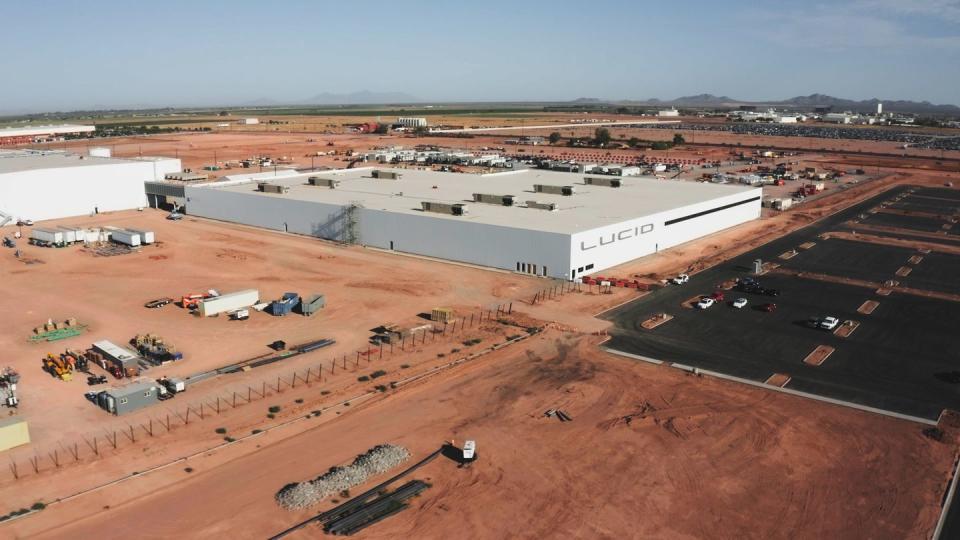
Lucid looked at 60 greenfield sites in 13 states before settling on this Arizona scrubland, Boike says. Upsides included proximity to suppliers (including in Mexico), solid infrastructure and Phoenix-area job applicants, plus “some of the flattest land I’ve ever seen,” Boike says, laughing. A reported $46.5 million in state and local tax breaks helped, though that pales before the potential $1.3 billion in public largesse that Tesla is receiving in Nevada.
Some skepticism naturally surrounds Lucid, as with any start-up looking to enter the notoriously hostile, capital-intensive auto industry. Can Lucid (or Rivian, et al.) really carve out a niche in an electric space dominated by Tesla and its Apple-like mythos, even as experienced legacy automakers seek to muscle in on the action? Viewed strictly on its design and performance merits, the Air suggests that Lucid has what it takes. Boldface items includes that 520-mile range (best in the industry to date, and 25 percent farther than Tesla’s best effort), a choice of 650 or 800 all-wheel horsepower in Touring and Grand Touring editions, eye-popping luxury, a 34-inch curved driver’s display and class-leading cargo space. Of course, automotive history is littered with innovative, smartly engineered cars (Chrysler Airflow, Tucker 48) that never quite caught on with the public. Nobody makes it on technical superiority alone.
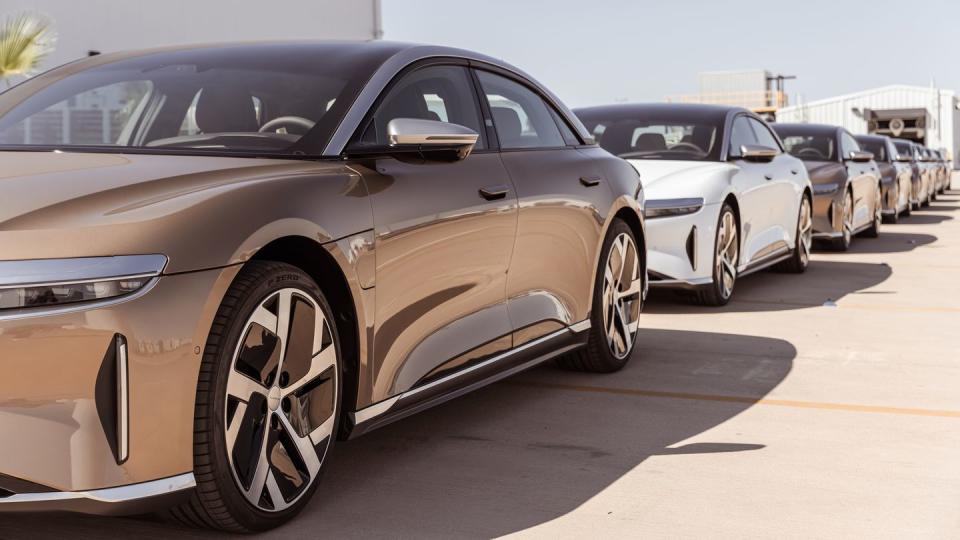
Lucid’s Sisyphean task starts with getting car shoppers to understand what a “Lucid” even is, while chasing Tesla’s 15-year head start. It includes speeding the most affordable Air, the $78,900 Pure, to market next year, followed by the Gravity SUV in 2023, likely the true make-or-break model for the company. It includes establishing viable networks of showrooms, service facilities and public charging, the latter pushed forward by three years of free refills on Electrify America’s growing national network. None of this comes easy, or fast. Rawlinson told me, with no apologies, that the guy in Montana who wants an Air will need to make some accommodations for now, just as Tesla required goodwill and patience from early adopters.
Rawlinson says more than 11,000 customers have paid reservations for an Air. And the ambitious growth strategy includes an ultimate production capacity of 365,000 cars a year in Arizona, with additional factories in Saudi Arabia, Europe and China. The ground is already cleared for a 2.85 million square-foot expansion in Arizona, the second of four planned phases, that will bump annual capacity to 90,000 units.
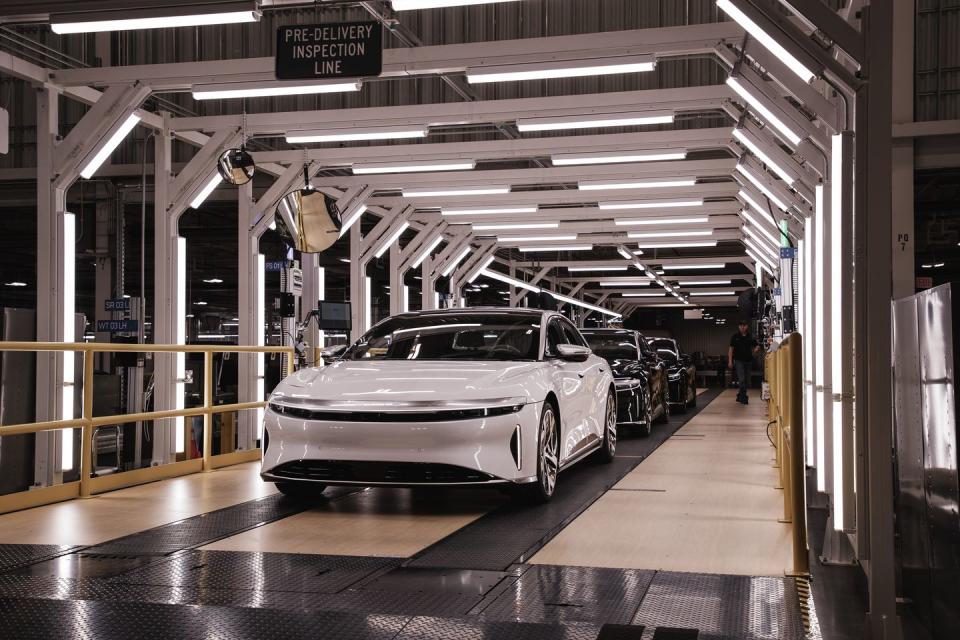
Lucid is also flush with investor cash, with a stock valuation near $33 billion—yes, before delivering its first car—and an impressive $4.5 billion raised in its public offering in July. That’s less than the deeper-pocketed Rivian, with $10.5 billion, but still a solid stake for Lucid to develop new models, expand its sales network and market itself to unfamiliar shoppers. Going public left the Saudi monarchy owning about 65 percent of Lucid. The Saudis view their Lucid investment as part of a long-term strategy to diversify their economy and become less dependent on oil exports. If Lucid being in business with Crown Mohammed bin Salman offends your sensibilities, well, sure: Perhaps you’ll consider boycotting the next time you pump Middle East unleaded into your Mustang, Porsche or pickup.
Tesla remains, by far, the most powerful automotive force on the planet. Lucid is no threat to that for now. Yet the Lucid Air not only matches Tesla’s vaunted tech and design, but beats it by nearly any objective or subjective measure: Decisively longer range, faster charging, greater efficiency, more and smarter sensors (including Lidar and driver monitoring), superior luxury and craftsmanship. Now we’ll see how many paying customers agree.
You Might Also Like

